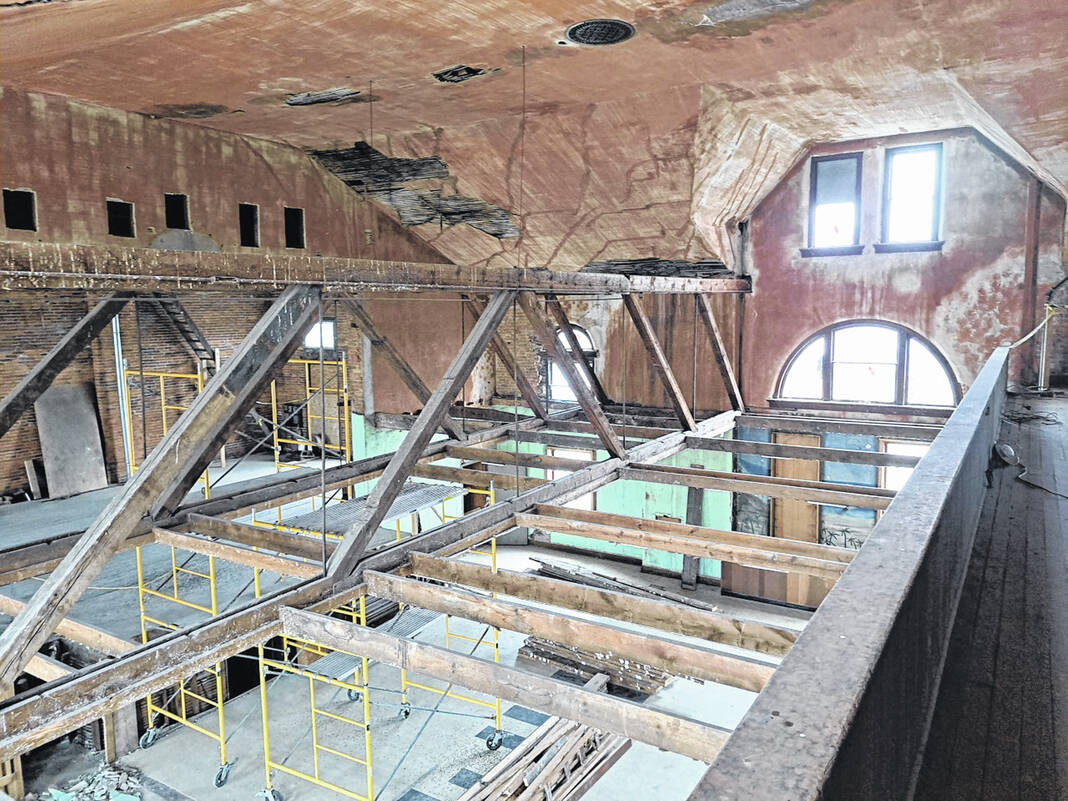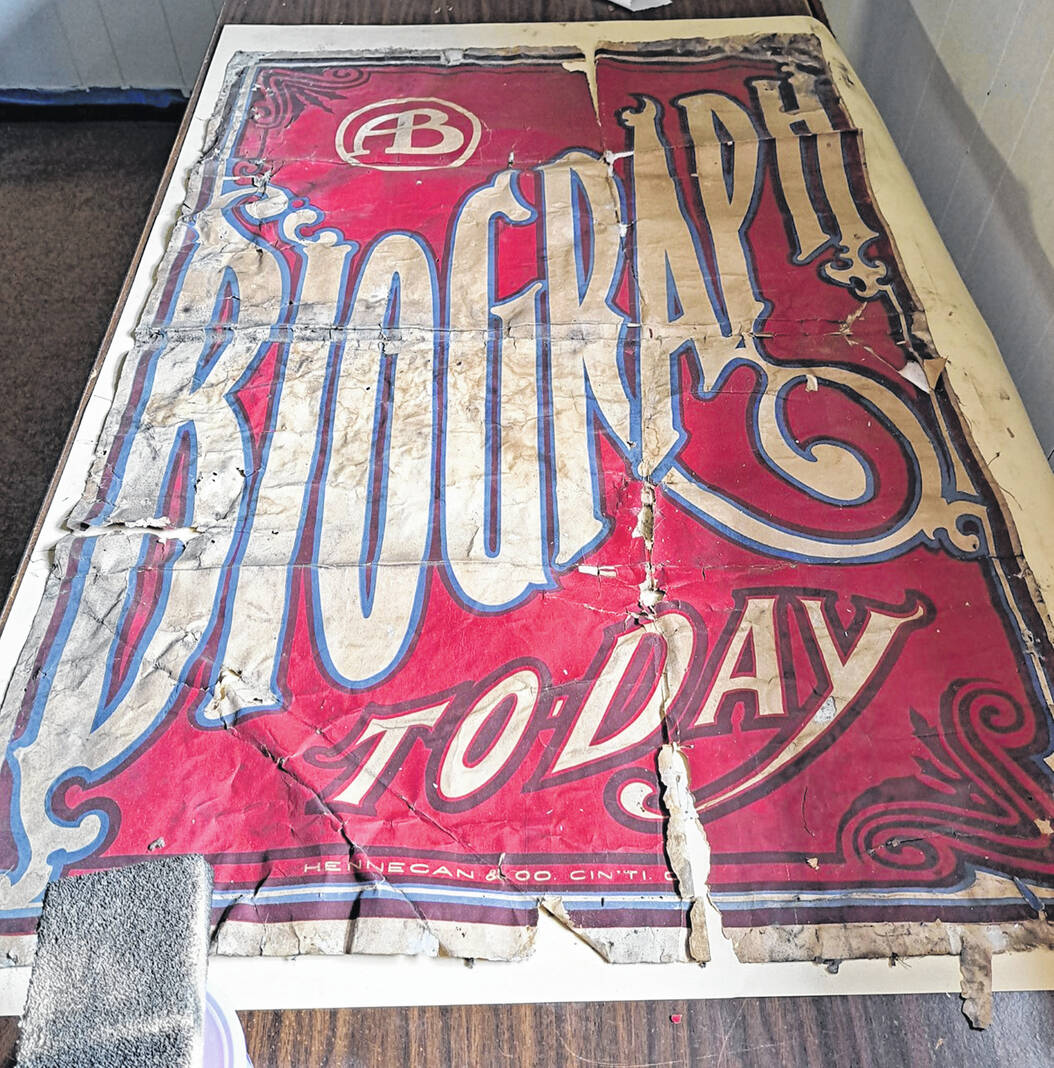
The original proscenium arch is intact, ready to reclaim its rightful place. The arch will frame the opening between the stage and auditorium, when restoration is complete.
Tammy Watts | Daily Advocate

The burnt orange fresco walls and ceiling were painted in 1906, or 1907. Fresco is painting done rapidly in watercolor on wet plaster, so that the color penetrates and become fixed as it dries.
Tammy Watts | Daily Advocate

An original poster was discovered, and is awaiting restoration.
Tammy Watts | Daily Advocate
By Tammy Watts
DailyAdvocate.com
ARCANUM — On the outside, the only changes in the grand old building’s appearance in recent months, have been the restoration of some its 100 windows. The inside, however, tells a love story of a small, but dedicated group, slowly breathing life into the Historic Town Hall and Opera House, located at 104 W. South St in Arcanum.
“The window sponsorship campaign sold out in six months,” said Angela Herron, Communications, Events and Social Presence Committee Chairperson for the Arcanum Preservation Society. “All the windows need to be removed, restored, and if there had been plexiglass installed, we’re replacing it with real glass.” Community involvement and donations are key to accomplishing the Arcanum Preservation Society’s mission of “returning the Opera House and other buildings in Arcanum to their full potential.” The Society was started in 2019, and was awarded nonprofit 501(c)(3) status in April 2020.
“We’re in the process of deconstruction,” Herron stated. False ceilings have been ripped out, creating an already noticeable improvement in the building’s acoustics. Volunteers discovered an original stairwell, ticket window, a trap room, and have been delighted with the condition of the original woodwork. “When we found that staircase, I told everyone not to touch a thing,” Herron recalled, “you never know what you might find.” Her instincts were proven correct: bits of newspapers from 1902 lined the stairwell, containing letters to Santa Claus, asking him for simple treats, like oranges. It was a reminder of the importance of preserving historical buildings, not only for the town’s architectural heritage, but as the Society states, “we lose a bit of ourselves, as well as our community’s, and local history with the loss of each building.”
Designed by architects Williams, Otter and Dexter, from Dayton, the Opera House was built in 1889. Construction was awarded to Arcanum resident and brick mason, Daff Vashti Zimmerman, while James Mellinger, who owned the mill across High Street from the Opera House, served as the interior contractor.
Herron described the restoration is a “labor of love;” it is all volunteer, with only four people working on the building’s vast interior. Another obstacle to the project, is that no one has found the original blueprints, and there are no interior photos. It is likely that they were all lost in the 1959 Weisenbarger building fire, which housed the Arcanum Public Library. The Society is trying to obtain grants to help finance the extensive restoration, but as the township owns two-thirds, and the village owns one-third, of the building, the process has to go through government entities, which can complicate paperwork.
The layers of additions, and remodeling, as the building served different purposes throughout the decades, has made returning the Opera House to its original condition a much more daunting task. In the 1930s, the auditorium was turned into the American Legion, as it was around that time that travelling troops started dying out, with the advent of motion pictures. Later, the building was home to the VFW, and the Lions Club, before serving as Town Hall. At one time, it housed the jail, township constable, police department, mayor, town council, tax offices, and township and village administration. The fire department utilized the building until 1974, when the new fire house was completed. With the original garage still intact, the Society hopes to borrow the original 1881 Ahrens steam pumper from the fire station, for photo opportunities, as restoration progresses. Some fire damage is still visible from 1982, when a police cruiser’s light bar caught fire. Fortunately, it was limited to the upper part of the garage.
On the upper floor, two sets of connected rooms were once used as a residence, and a doctor’s office. Herron once talked with a lady who remembered visiting her grandparents, as a little girl, when they lived in the upstairs room.
In the auditorium, a transient man who stayed in the building periodically, when the VFW moved in, painted murals depicting battle scenes of WWI and WWII. On one wall, trenches and barbed wire illustrate a WWI battle; on another, the palm trees and sands of WWII’s Pacific Theater, and a battleship.
In a room adjacent to the seating area, signatures, and an occasional drawing adorn the walls. Webster Baker signed all four of the room’s walls in 1915. “He really wanted us to remember him,” Herron chuckled. However, the oldest signature belongs to Fred Smith, who left his autograph on Jan. 3, 1893. A newer inscription, dated 1977 was written while the author was hiding from police, watching through the window as they searched for him.
The stage has four trap doors, and the trap room most likely served as an entry way for the orchestra. The room could have been used for costume changes, but most often, train cars served as dressing rooms for the traveling performers, due to the Opera House’s close proximity to the railroad tracks.
Herron believes once the restoration is complete, there will be concerts, dance recitals, high school plays, weddings, showers, and possibly a practice venue for Greenville’s St. Clair Memorial Hall performances.
“It will be so wonderful to have singing in here again,” said Herron, discussing caroling planned for December in the Opera House.
Before that, however, there will be an event, “Got Ghost? Are We Haunted?” on September 17, from 1 -5 p.m. The public can take tours of the Opera House, see the results of two paranormal investigations, and participate in a Victorian séance. There will also be photo booths available. For more information, visit the Arcanum Preservation Society Facebook page, follow on Instagram, Twitter, or call 937-459-1157.




